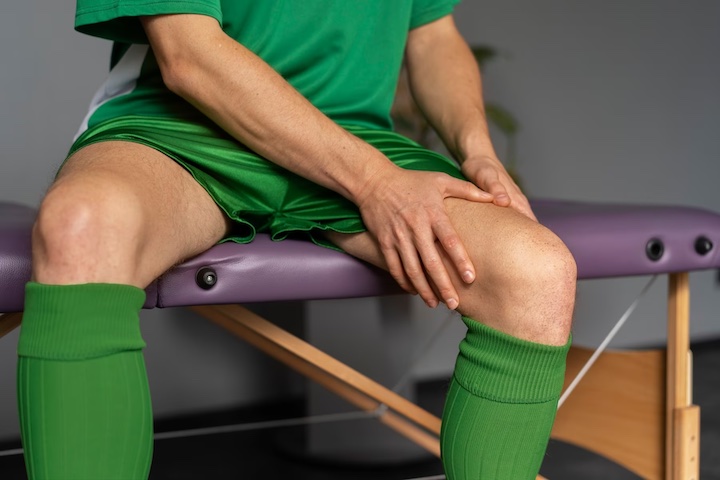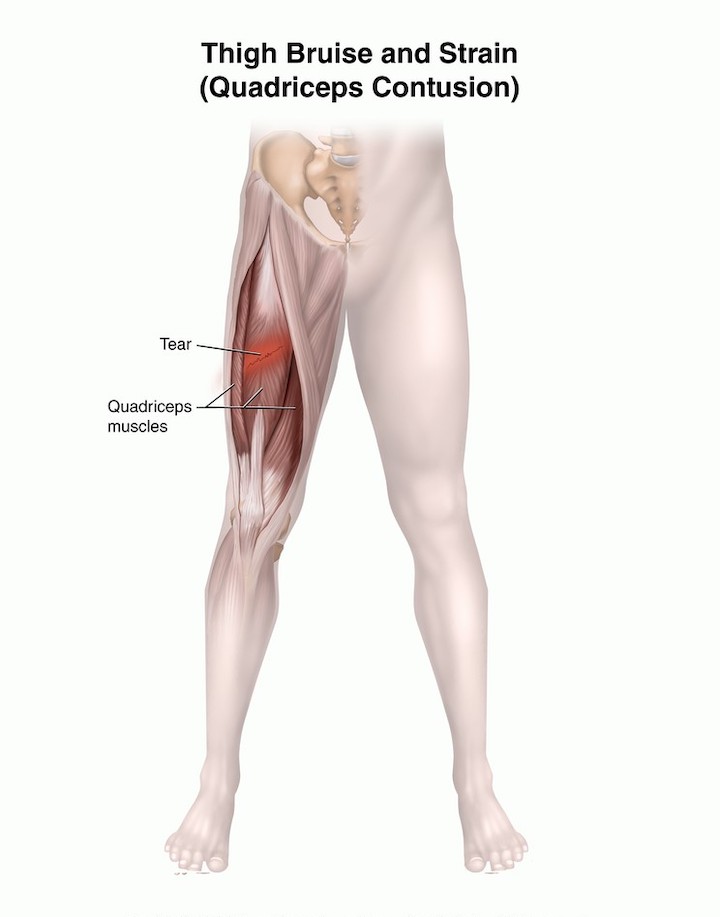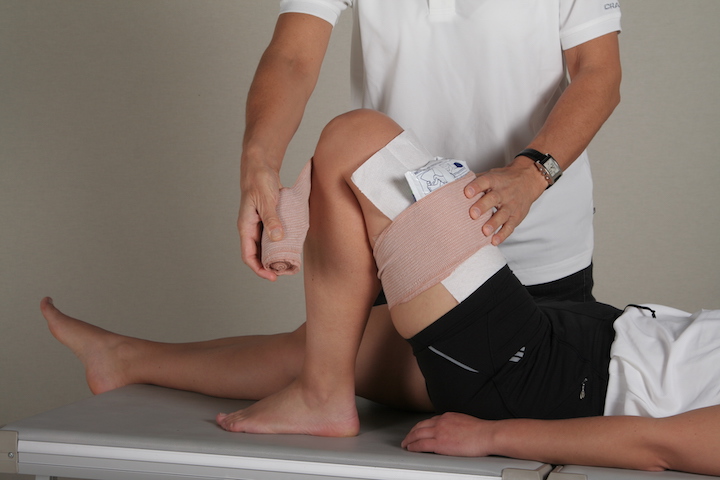A ‘Corked Thigh‘, also known as a quadriceps contusion, is a common sports injury that results from direct impact to the front of the thigh. This often occurs in contact sports such as rugby or soccer, where blunt force trauma can cause damage to the muscles and surrounding tissue.
The name ‘corked’ derives from the sensation of pressure that many patients describe, likening it to a champagne cork wedged into their leg. While not typically life-threatening, this condition can lead to significant discomfort and functional limitations if not adequately managed.
Participation in high-impact sports or activities where direct blows to the leg is likely to increase the risk of sustaining a deep tissue bruise or contusion, commonly referred to as a corked thigh or contusion. This type of injury occurs when an external force is applied to the thigh muscles causing damage to muscle fibres and surrounding blood vessels. The subsequent bleeding into the tissues leads to pain, swelling and restricted movement.
It should be noted that while sporting incidents are often responsible for corked thigh injuries, other causes might include falls, accidents or any blunt trauma inflicted on the thigh area causing a certain level of thigh pain.
Corked thigh risk factors extend beyond participation in contact sports. Individuals with previous leg injuries may have weakened muscles more susceptible to this type of injury. Similarly, inadequate warm-up before exercise can increase susceptibility to obtaining a contusion in the thigh. Age could be another factor affecting vulnerability; as age increases, muscle elasticity decreases, potentially making them more prone to damage from impact forces.
Understanding these causes helps individuals take preventative measures and manage personal risks effectively, thereby reducing potential incidences of sustaining such an injury.
Deep tissue contusions in the leg, often resulting from high-impact activities or blunt force trauma, can be classified into various types based on the severity and extent of the thigh injury. These injuries, commonly referred to as ‘corked thigh’, range from mild to severe and are typically graded as first-degree (mild), second-degree (moderate), and third-degree (severe).

Photo Credit: Freepik
A first-degree corked thigh is characterised by minimal pain and discomfort where the person may continue with their activity despite the injury. A second-degree corked thigh involves greater muscle damage, causing noticeable pain that can limit physical activity. In the case of a third-degree corked thigh, there’s an extensive tear or rupture in the muscle, which results in severe pain and difficulty in moving the affected limb.
The feeling associated with a corked thigh varies depending upon its grade; it could feel like a nagging ache for minor cases to intense throbbing pain for more severe instances. Understandably, recovery time is also contingent upon this grading system. At the same time, a first-degree corked thigh may require just one or two weeks for complete healing, a severe third-degree injury could take several months.
It’s critical during this period to follow appropriate treatment protocols to promote healing and prevent complications. One is compartment syndrome – a serious condition where increased pressure within one of the body’s muscular compartments leads to muscle and nerve damage. Therefore, regardless of the type of corked thigh sustained, seeking immediate medical attention followed by proper rest, icing regimen, compression therapy, and gradual return to activity under professional supervision forms an integral part of an effective treatment strategy reducing overall recovery time.
Identifying the extent and severity of a deep tissue discolouration in the leg necessitates a comprehensive diagnostic process. This involves a thorough physical examination, and a review of medical history and the circumstances surrounding the injury.

Photo Credit: McKesson Corporation
Medical practitioners often rely on corked thigh images obtained from ultrasound scans or magnetic resonance imaging (MRI) to visualise any internal swelling or bleeding that isn’t externally visible, especially when there is a suspected corked thigh but no bruise present. The imaging techniques can also help detect any potential corked thigh blood clot formation, which could pose serious health risks if left unattended.
In understanding how to diagnose a corked thigh, it’s essential to recognise that symptoms may not just be localised to the area of impact but also radiate towards other regions, like causing knee pain. For instance, an individual with this condition may experience an inability to contract their muscles fully, diminished strength, or even limping due to discomfort in weight-bearing activities.
A professional physical assessment helps determine these inconsistencies and aids in formulating an effective treatment plan. Hence, proper diagnosis is essential in managing this condition effectively and preventing potential complications such as myositis ossificans or compartment syndrome, which could arise from untreated severe cases.
The immediate response on how to treat a corked thigh usually involves the R.I.C.E protocol (Rest, Ice, Compression and Elevation). Rest allows the injured tissues time to heal; ice helps reduce inflammation by constricting blood vessels; compression with elastic bandage reduces swelling and provides support; and elevation above heart level promotes venous return, thus reducing edema.
Applying heat should be avoided initially as it can increase bleeding in the damaged tissues; therefore, corked thigh ice or heat decision leans towards using ice at least within the first 72 hours post-injury.

Photo Credit: FitToPlay
Subsequent treatment for corked thigh often includes physiotherapy, where specific exercises play a pivotal role in helping regain normal function of the leg muscles. Corked thigh exercises are often progressive, beginning with gentle range of motion activities before moving on to strength-building routines. A gradual return-to-activity program designed by a healthcare professional can help ensure a safe return to sport or other physical tasks without reinjuring the muscle.
Depending on the severity of the injury and the patient’s adherence to recommended therapy, corked thigh recovery time can vary from several days to a few weeks.
Guided rehabilitation plays a crucial role in ensuring effective recovery from deep tissue contusions in the leg, with the duration of this process varying depending on the injury’s severity and adherence to prescribed treatment plans.
The corked thigh recovery process is typically broken down into three stages: immediate post-injury management, a gradual return to activity, and full recovery.
Immediate post-injury management involves rest, ice application, compression and elevation (RICE) protocol, and pain relief measures. This stage focuses on minimising damage and reducing inflammation to speed up healing.
In terms of how long a corked thigh takes to heal, it’s important to note that each person’s body responds differently to trauma; however, generally speaking:
During this time, it’s critical to heal a corked thigh and prevent further damage or re-injury during the rehabilitation phase. Corked thigh rehab often includes exercises designed specifically for strengthening and restoring flexibility within the affected muscle group.
Returning too quickly or without proper precautions could risk worsening the condition or prolonging recovery from the corked thigh.
While it may not be possible to prevent all corked thigh injuries, you can take certain precautions to minimise the risk:
If you have a corked thigh, you may experience immediate pain, tenderness, swelling, bruising, limited range of motion, muscle stiffness, and possible numbness or tingling sensation in the thigh area.
To heal a corked muscle, follow these steps:
The healing time for a corked muscle varies depending on the severity of the injury. Mild to moderate corked muscles typically take a few days to a few weeks to heal. Severe cases may require a longer recovery period and extensive rehabilitation.
A corked muscle may feel painful, tender, and swollen. You may experience limited range of motion, muscle stiffness, and possibly numbness or tingling sensation in the affected area. The muscle may also show signs of bruising due to internal bleeding caused by the impact.
Subtle symptoms of a thigh contusion may include reduced mobility, lingering discomfort during rest or movement, and a slight change in the shape or appearance of the affected area. These may take time to be apparent.
Certain sports or physical activities, particularly those involving direct contacts, such as rugby or soccer, tend to report a higher occurrence of thigh contusions, colloquially termed ‘corked thighs’, due to their inherent risk factors.
Untreated muscle contusions, such as a ‘corked thigh’, may lead to long-term complications. These include myositis ossificans (bone growth within the muscle) and chronic pain, thus necessitating prompt and appropriate treatment.